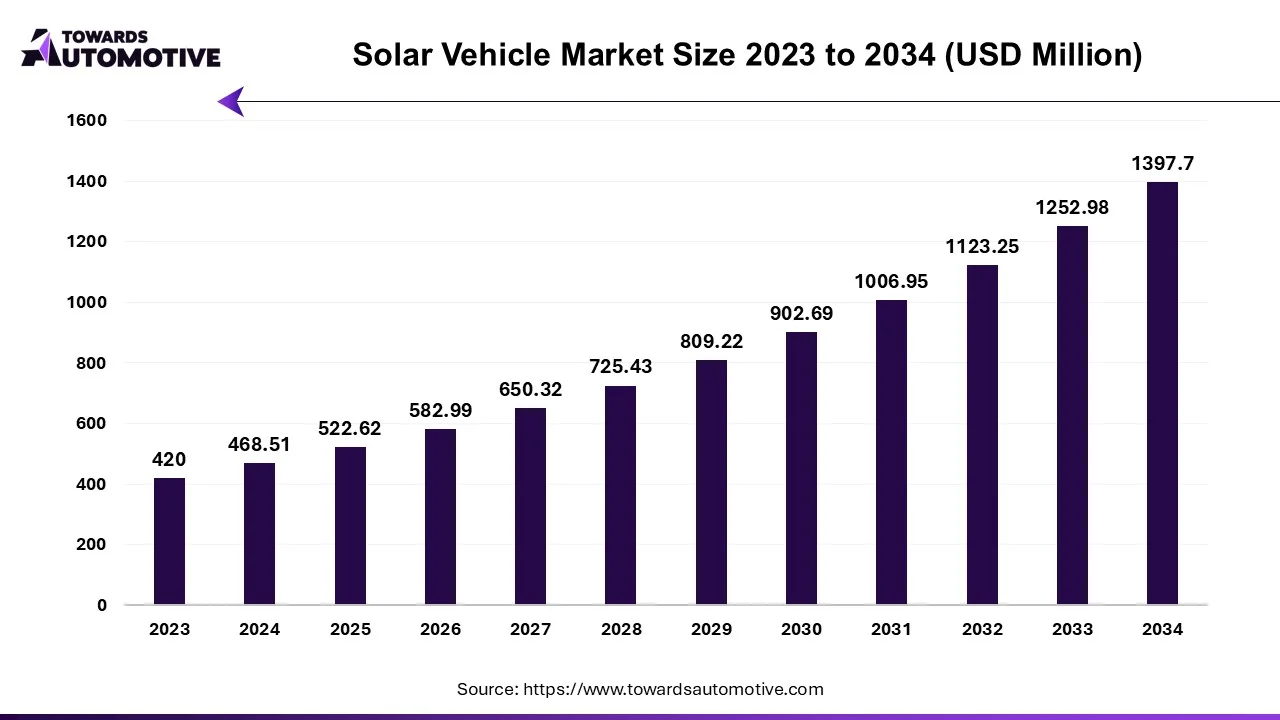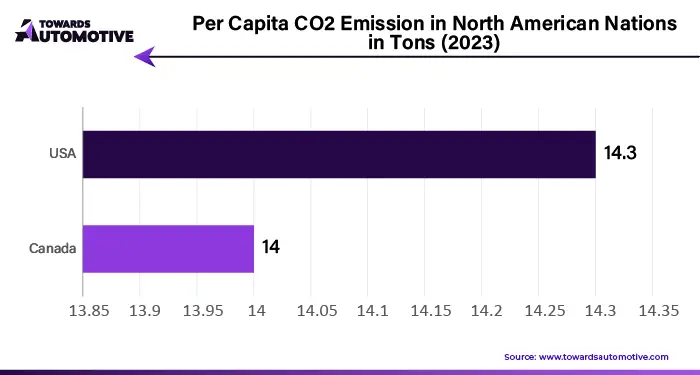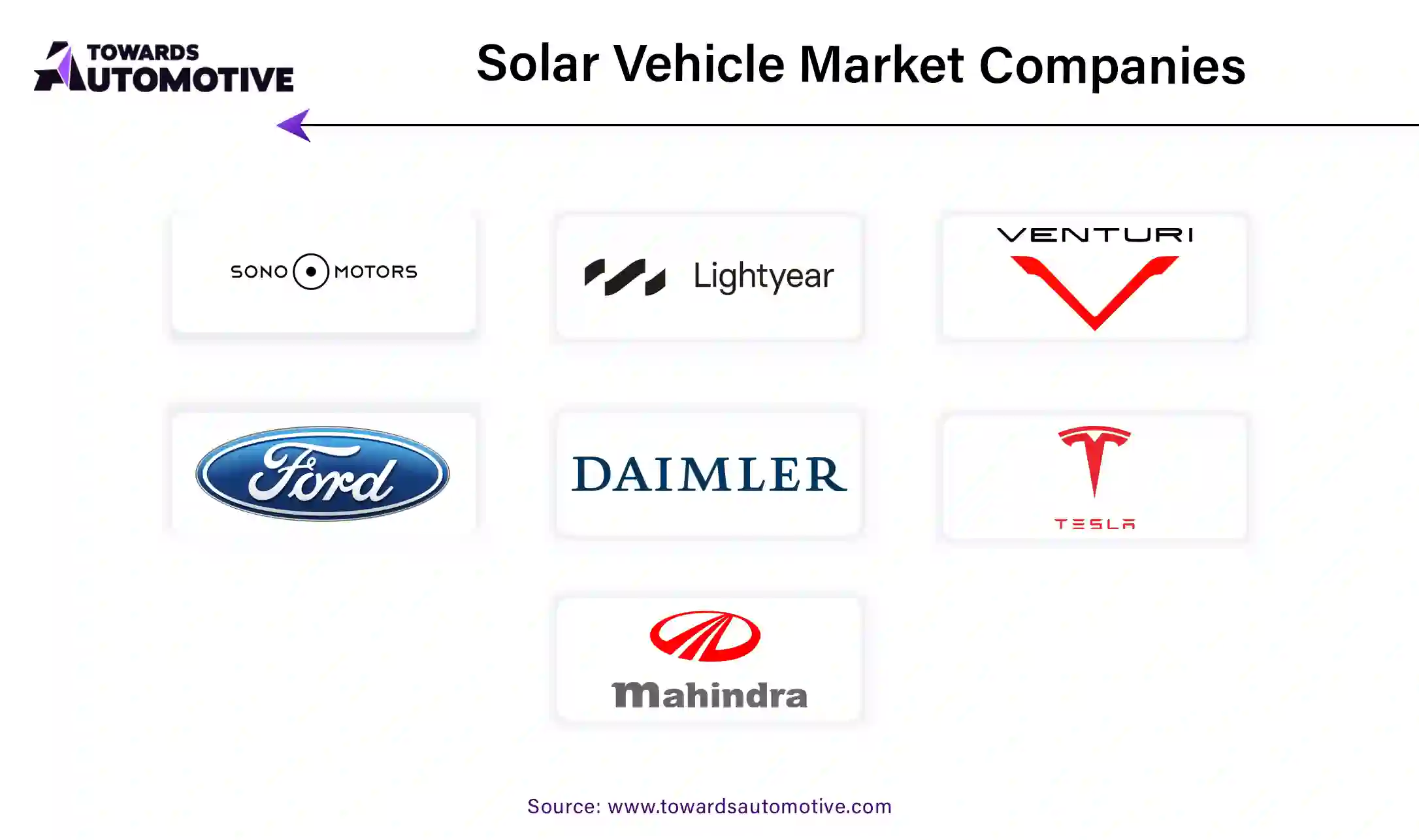October 2025
The global solar vehicle market is set to grow from USD 522.62 million in 2025 to USD 1397.7 million by 2034, with an expected CAGR of 11.55% over the forecast period from 2025 to 2034.

The solar vehicle market is an emerging segment within the transportation industry, driven by the global shift toward sustainable energy solutions. Solar vehicles use photovoltaic panels to capture sunlight and convert it into electricity, which powers electric motors, providing an eco-friendly alternative to traditional gasoline and diesel-powered vehicles. As concerns over environmental sustainability, air pollution, and climate change continue to rise, the demand for green transportation solutions, including solar-powered vehicles, is gaining momentum. Solar vehicles not only reduce greenhouse gas emissions but also help reduce dependence on fossil fuels, contributing to energy conservation and a cleaner environment. The market is being shaped by technological advancements in solar panel efficiency, energy storage systems, and the integration of electric vehicle (EV) technologies.
Government incentives and growing investments in renewable energy infrastructure further fuel the adoption of solar vehicles. Additionally, the expansion of solar-powered electric cars, buses, and even commercial vehicles across various sectors, including personal transportation, public transit, and logistics, presents significant growth opportunities. As manufacturers and innovators continue to explore ways to integrate solar technology into mobility solutions, the solar vehicle market holds immense potential to redefine the future of transportation, providing sustainable, energy-efficient options for a greener tomorrow.
AI is playing a transformative role in the solar vehicle market by enhancing efficiency, performance, and overall user experience. In solar vehicles, AI is integrated into various systems, such as energy management, navigation, and predictive maintenance. AI-powered energy management systems optimize the use of solar power by analyzing weather patterns, vehicle speed, and battery levels, ensuring that energy from the solar panels is used efficiently. This helps improve the range and overall performance of solar-powered electric vehicles, reducing the reliance on external charging infrastructure.
AI also aids in optimizing battery performance by monitoring charging cycles and predicting battery life, enabling more effective energy storage solutions. In terms of navigation, AI can analyze real-time data to suggest routes that maximize solar energy usage, taking into account factors like road conditions, sun exposure, and driving habits. Additionally, AI-driven predictive maintenance allows for early detection of potential issues with the solar panels, electric motor, or other vehicle components, reducing downtime and repair costs.
Furthermore, AI contributes to autonomous driving capabilities in solar vehicles, enhancing safety and efficiency. As solar vehicle technologies evolve, AI will continue to be a key enabler, driving innovation and accelerating the adoption of solar-powered transportation solutions. Its role in energy management, predictive analytics, and automation is essential in making solar vehicles more efficient, reliable, and practical for mass adoption.
Government initiatives aimed at adopting solar energy are playing a pivotal role in driving the growth of the solar vehicle market. In many regions, governments are introducing policies, incentives, and regulations that encourage the development and adoption of solar-powered vehicles as part of broader efforts to reduce carbon emissions and combat climate change. Financial incentives such as tax credits, rebates, and grants for both manufacturers and consumers are making solar vehicles more affordable, thereby accelerating their adoption. These government-backed initiatives not only lower the upfront costs of solar vehicles but also reduce the overall cost of ownership, making them a viable option for a wider range of consumers.
Additionally, governments are setting ambitious targets for reducing greenhouse gas emissions and transitioning to clean energy, which includes promoting solar power as a key solution. These targets are encouraging automakers to invest in solar vehicle technology, ensuring that the industry moves towards greener, more sustainable alternatives to traditional internal combustion engine (ICE) vehicles. For example, in countries like the United States and members of the European Union, national and local governments are setting policies that require a greater percentage of vehicles sold to be electric or zero-emission, creating an environment for adoption of solar vehicles.
Moreover, public-private partnerships and funding for research and development in solar and battery technology are accelerating innovation in the solar vehicle sector. By supporting the infrastructure for solar energy generation, storage, and charging, governments are creating a more conducive environment for solar vehicles to flourish. These combined initiatives help establish a solid foundation for the continued growth of the solar vehicle market, ensuring that solar-powered transportation becomes a mainstream solution for sustainable mobility.
The solar vehicle market faces several restraints, including limited energy generation capacity of solar panels, which affects the range and performance of solar-powered vehicles, especially in regions with limited sunlight. High production costs of solar panels and integration into vehicle designs also pose financial challenges, making solar vehicles more expensive compared to traditional electric vehicles. Additionally, insufficient infrastructure, such as solar charging stations, and consumer skepticism regarding the reliability and practicality of solar vehicles further hinder market growth and widespread adoption.
Technological advancements in polycrystalline solar panels are creating significant opportunities in the solar vehicle market by improving efficiency, reducing costs, and enhancing overall performance. Polycrystalline panels, which are made from silicon crystals, have traditionally been less efficient compared to monocrystalline panels. However, recent innovations have led to improvements in their energy conversion rates, making them a more viable option for solar-powered vehicles. Enhanced manufacturing techniques, such as better wafer cutting and improved panel designs, have increased the energy output of polycrystalline solar panels without significantly increasing their production costs. This makes them more affordable for automakers and consumers, allowing for wider adoption of solar vehicles.
Moreover, the lighter weight and flexibility of polycrystalline panels, when combined with advancements in materials science, make them easier to integrate into the design of vehicles without compromising aesthetics or structural integrity. The improved performance of these panels also allows for better energy storage, extending the driving range of solar vehicles and making them more practical for everyday use. As polycrystalline solar panels become more efficient and cost-effective, their adoption in the solar vehicle market will drive the development of more sustainable and energy-efficient transportation solutions, contributing to the global shift towards clean and renewable energy sources.
The lithium-ion segment held the largest share of the market. The lithium-ion segment is a key driver in the growth of the solar vehicle market due to its superior energy storage capabilities, long lifespan, and efficiency. Lithium-ion batteries are lightweight, compact, and offer higher energy density compared to other battery types, making them ideal for use in solar-powered vehicles where weight and space are crucial factors. These batteries store the energy generated by solar panels, ensuring that vehicles can run even during periods of limited sunlight or at night. As solar vehicles depend heavily on efficient energy storage, the growing adoption of lithium-ion batteries is crucial for enhancing their performance and driving range.
Moreover, continuous advancements in lithium-ion technology, such as improved charging speeds and longer lifespans, are further fueling the growth of the solar vehicle market. The decreasing cost of lithium-ion batteries also plays a significant role in making solar-powered vehicles more affordable for consumers. As solar vehicles become more economically viable and efficient, the demand for lithium-ion batteries is expected to rise, boosting the overall market for both solar vehicles and energy storage solutions. This synergy between solar power generation and efficient energy storage is key to making solar vehicles a practical and sustainable transportation solution.
The monocrystalline segment led the industry. The monocrystalline segment plays a vital role in driving the growth of the solar vehicle market due to its high efficiency and energy output. Monocrystalline solar panels are made from a single continuous crystal structure, which allows them to achieve higher energy conversion rates compared to other types of solar panels. This makes them highly effective in capturing and converting sunlight into electricity, a critical factor for solar vehicles that rely on solar energy for propulsion. As a result, monocrystalline panels are increasingly being integrated into solar-powered vehicles to maximize energy efficiency and extend the vehicle’s range.
Furthermore, advancements in monocrystalline solar panel technology, such as improved cell designs and enhanced performance under low-light conditions, are further boosting their adoption in the solar vehicle market. Although monocrystalline panels tend to be more expensive than other types, their long-term benefits in terms of performance and durability justify the higher initial investment. The growing demand for efficient, eco-friendly transportation solutions is driving automakers to incorporate monocrystalline panels into their solar vehicle designs, making solar vehicles a more viable alternative to traditional fossil-fuel-powered vehicles. This, in turn, accelerates the overall growth of the solar vehicle market.
Asia Pacific dominated the solar vehicle market in 2023.. In the Asia Pacific (APAC) region, rising investment in solar infrastructure, consumer demand for sustainable mobility, and corporate investments and collaborations are crucial drivers of the solar vehicle market. The increasing investment in solar infrastructure, including solar-powered charging stations and solar energy solutions, plays a pivotal role in supporting the adoption of solar vehicles. Governments across APAC, particularly in countries like China and India, are ramping up efforts to integrate renewable energy into transportation systems. The expansion of solar charging networks makes it easier for consumers to own and operate solar vehicles, overcoming concerns about charging accessibility and range limitations, which accelerates market growth.
Simultaneously, the demand for sustainable mobility in APAC is surging due to rising awareness of environmental issues and the need to reduce carbon emissions. With growing concerns over air pollution and climate change, consumers are increasingly turning to eco-friendly alternatives to traditional vehicles. Solar vehicles, which provide clean, zero-emission transportation, are seen as an attractive solution. In countries like Japan and South Korea, consumers are particularly receptive to clean technology, further driving the market growth.
Corporate investments and collaborations are also vital for the market’s expansion. Leading automakers in the APAC region, including Toyota, Hyundai, and BYD, are increasingly focusing on solar-powered technologies for their vehicles. These companies are partnering with renewable energy firms and research institutions to develop and scale up solar vehicle solutions, which in turn drives innovation and lowers production costs. The combination of infrastructure development, rising consumer demand, and industry collaboration creates a favorable environment for the growth of the solar vehicle market in APAC.
North America is expected to grow at the fastest rate in the solar vehicle market during the forecast period. In North America, government policies and incentives, technological advancements in solar and battery technology, and growing environmental concerns are driving the growth of the solar vehicle market. Governments in the region, particularly in the U.S. and Canada, are introducing favorable policies, subsidies, and tax incentives to encourage the adoption of clean energy solutions, including solar-powered vehicles. These incentives make solar vehicles more affordable and accessible for consumers, while also encouraging manufacturers to invest in the development of more efficient and cost-effective solar technology. Furthermore, stricter environmental regulations and emission reduction targets are motivating both governments and industries to seek sustainable alternatives to conventional fossil-fueled transportation.
Technological advancements in solar and battery technology are also playing a critical role in accelerating the solar vehicle market. Innovations in solar panel efficiency, along with improvements in battery storage and energy management systems, have enhanced the performance and practicality of solar vehicles. The reduction in the size and weight of solar panels, combined with longer battery life, makes it easier for manufacturers to integrate solar energy into vehicles without compromising design or functionality. These advancements enable solar vehicles to travel longer distances, which addresses one of the major concerns about their practicality.
Moreover, environmental concerns and a growing emphasis on sustainability are pushing consumers and industries to adopt greener mobility solutions. With rising awareness of climate change and pollution, there is an increasing demand for zero-emission vehicles. Solar vehicles, which harness clean energy and emit no pollutants, are seen as a solution to these environmental challenges, further boosting their market growth in North America.


By Vehicle Type
By Battery Type
By Solar Panel Type
By Region
October 2025
October 2025
October 2025
October 2025
We offer automotive expertise for market projections and customizable research, adaptable to diverse strategic approaches.
Contact Us